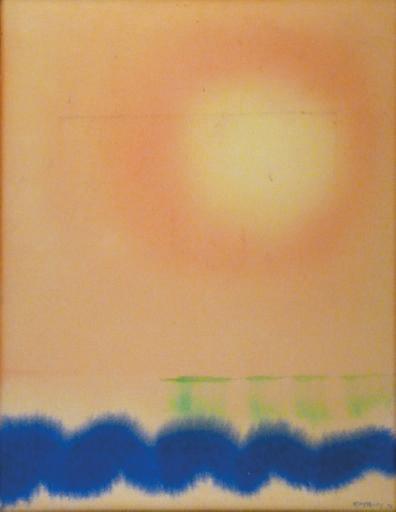
“Aura I” (1975) by Catharine McAvity
Cancer, Comics, and the Healing Power of Art
“Joy gives us wings!” ‘Abdu’l-Bahá tells us. “But when sadness visits us we become weak . . .” — in other words, we land, and sometimes fall hard, on the cold ground. But both emotions, ‘Abdu’l-Bahá assures us, “come from the world of matter.”1 We need not heed them: they are as fleeting as the clouds that pass overhead. And what is left once they vanish? If we have detached ourselves from the material world and learned to drink deep from that bottomless cup of joy that is spirituality, then transformation.
In this new issue of e*lix*ir, we cover much ground, traveling from joy to the pain of loss then onwards and upwards to the exalted realm that is the scene of spiritual transformation. Perhaps nowhere in this issue is the long journey towards such transformation more fully documented than in the paintings of New Brunswick artist Catharine McAvity, who was launched on her career as a painter by the tragic loss of a child. In the art she produced over several decades, we witness her search to inscribe her grief in a poetry of light.
In “A Landscape Yearning Towards the Light: A Year with the Paintings of Catharine McAvity,” I write about living among Catharine’s paintings in the months after cancer treatment, how they helped bring me out of the darkness of illness and into the light of health. Living in a house filled with Catharine’s paintings brought me hope and inspiration, not to mention the blessed forgetfulness of “the unpleasant things of life,”2 as ‘Abdu’l-Bahá puts it in one of His prayers, that comes from living in the presence of beauty. Who would expect an artist to inscribe her sorrow in landscapes vibrant with color and light? Who would expect the experience of cancer to give one true health — spiritual health in the form of peace of mind?
And who would expect that enduring a restrictive dress code, as women routinely do in Iran, could become the theme of a comic? In “Ruhi & Riaz,” Eira takes a humorous look at what can happen when one is pulled over by the hijab police who rove the streets of Iran’s cities looking for women who have violated — even if the only real culprit is a gust of wind! — the rule of hijab. We hope this comic will be an ongoing feature in e*lix*ir so that readers have the opportunity to learn more about life in Iran, particularly for Bahá’í youth.
In Shahin Mowzoon’s translation of a well known poem by an iconic nineteenth century woman poet, we hear a cry of yearning to meet the Báb, the Gate to a new revelation, face to face. Tahirih’s perfect and all consuming love is a thing of beauty before which we may feel we can only stand in awe, but such perfect love can also serve as an inspiration to us in our own quest for closeness to our Beloved.
Why translate, yet again, such a well known and already so beautifully translated poem? As Shahin Mowzoon puts it, “The work of translation is like painting: different artists can paint the same scene, but render it differently, according to their unique angle or view. Translation is like that: each individual renders the original according to his or her own understanding of the words and their meaning.” It is our hope that a new translation of this familiar poem will bring readers a fresh perspective on a theme so rich and so skillfully expressed in the original that it can never be exhausted.
Featured in the poetry section of this issue, James Andrews’ poems offer readers glimpses of a visionary landscape, one in which a young boy, sensing there is something beyond the small world in which he was raised, climbs a ladder and, from this high vantage point, suddenly becomes aware of faraway lands, especially the countries of the East. The moral landscape of Andrews’ poems is a deeply imagined one in which prejudice is rejected and love quickens the soul as the body engages with the mundane realities of life.
In the review section, we take a look at some of the best Bahá’í books for children published in the past year. During the year that separates the commemoration of the Bicentenary of the Birth of Bahá’u’lláh in 2017 from the Bicentenary of the Birth of the Báb in 2019, we continue to focus our thoughts on these two Central Figures of the Bahá’í Faith. It seems fitting, therefore, that the books reviewed in this issue explore various aspects of their lives.
Finally, in the “Voices of Iran” section, we present “Sweet Fruit,” an essay in which Anisa Bahamin gives an account of her unexpected triumph over the forces of darkness when a supervisor threatens to fire her from her job because she will not recant her faith.
If music is, as Bahá’u’lláh tell us it is, “a ladder for [our] souls,”3 why cannot writing and painting also serve as a means of ascent, an invitation to leave behind the “things of this world” and embrace the “things” of another, higher realm? As you read this issue of e*lix*ir, we invite you to climb the rungs of the ladder, to imbibe the healing power of art and be transformed.
— SLH
Footnotes:
1 - “Joy and Pain,” Paris Talks, p. 109.
2 - Bahá’í Prayers: A Selection of Prayers Revealed by Bahá’u’lláh, the Báb, and Abdu’l-Bahá, p. 152.
3 - The Kitab-i-Aqdas, pp. 34-49, gr. 51.